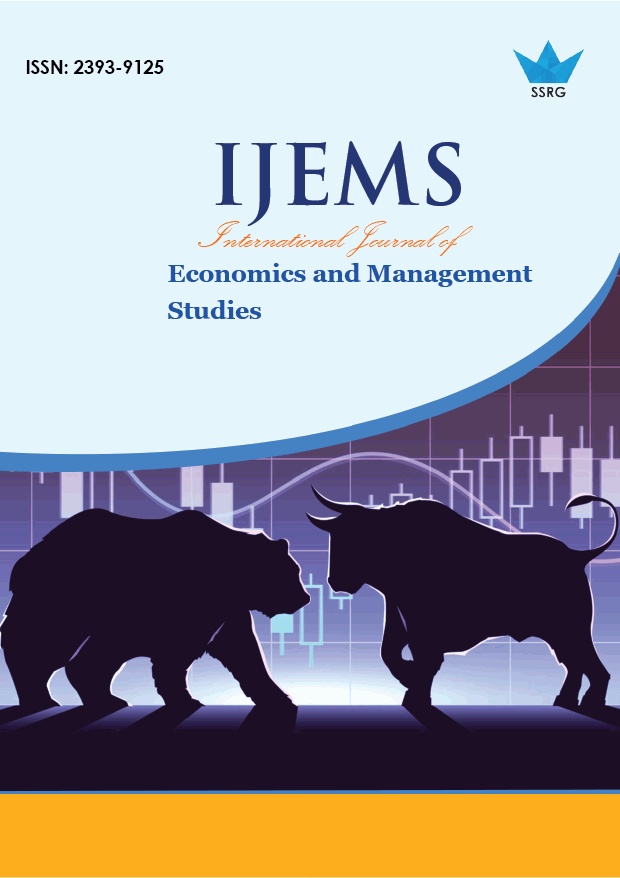Industrial Labours in Ethnic Minority and Mountainous Regions of Vietnam – Situation and Solutions in a Training Innovation Context

| International Journal of Economics and Management Studies |
| © 2022 by SSRG - IJEMS Journal |
| Volume 9 Issue 3 |
| Year of Publication : 2022 |
| Authors : Ha Thi Thu Thuy, Vu Van Anh |
How to Cite?
Ha Thi Thu Thuy, Vu Van Anh, "Industrial Labours in Ethnic Minority and Mountainous Regions of Vietnam – Situation and Solutions in a Training Innovation Context," SSRG International Journal of Economics and Management Studies, vol. 9, no. 3, pp. 9-16, 2022. Crossref, https://doi.org/10.14445/23939125/IJEMS-V9I3P102
Abstract:
The mountainous region of Vietnam has great potential for developing the energy industry, agro-forestry product processing industry, mining and metallurgy industry. To promote the development of industry in ethnic minorities and mountainous areas of the country, in recent years, Vietnam has been choosing to follow the path of industrialization development, which poses urgent requirements on the quality and skills of the labour force. The Northern Ethnic Minority and Central Highlands regions of Vietnam are two regions with a lower percentage of trained workers compared to other regions. However, the labour force in the industry in the ethnic minority and mountainous areas is constantly increasing and has many fluctuations. The labour force tends to decrease the proportion of women and increase the proportion of men. Industrial workers' educational and technical qualifications are lower than the national average and many other regions. To increase the quantity, improve the quality and effectively use the industrial labour force, these regions need to carry out synchronous solutions such as stabilizing the quantity, improving the quality of industrial training, and solutions to develop the industrial workforce associated with developing socio-economic, labour market adjustment solutions will contribute to the regulation of labour, use of labour with the right professional capacity, improve labour productivity, stimulate production development.
Keywords:
Industrial labour, Ethnic minority and mountainous areas, Raining solutions, Innovation in education and training.
References:
[1] Cuong Nguyen Quoc, FeiYe, Study and evaluation on ADB, VIET NAM: Technical and Vocational Education and Training Sector Assessment (2020).
[2] Sustainable industrial development in the Mekong Delta of Vietnam, Journal of Cleaner Production, Volume 86, 1 January 2015 (2015) 389-402.
[3] Do, Ha Thi Hai et al. Impact of Vocational Training on Wages of Ethnic Minority Labors in Vietnam. The Journal of Asian Finance, Economics and Business, 7, (6), Korea Distribution Science Association, June (2020) 551–560.
[4] General Statistics Office of Vietnam, Committee for Ethnic Minority Affairs, Collecting information on the socio-economic status of 53 ethnic minorities in 2019 - Survey results, Statistical Publishing House(2019).
[5] General Statistics Office of Vietnam, Labor force Survey 2020(2021).
[6] General Statistics Office of Vietnam website, https://www.gso.gov.vn/.
[7] General Statistics Office (GSO) and Committee for Ethnic Minority Affairs (CEMA), Survey on the Socioeconomic Situation of 53 Ethnic Minority Groups in 2015 (2015).
[8] General Statistics Office (GSO) and Committee for Ethnic Minority Affairs (CEMA), Survey on the Socioeconomic Situation of 53 Ethnic Minority Groups in 2019 (2019).
[9] Hasmath, R., Ho, B., & Liu, E. M. Ethnic minority disadvantages in China’s Labor Market. CGC Discussion Paper Series No.16(2012), University of Oxford.
[10] Hung, Ta Ba et al., China's strategies and policies to promote innovation in higher education and training of skilled workers, National Science and Technology Information Bureau, August(2010)(Vietnamese article).
[11] ILO, Employment Creation Potential of the Ethnic Minority Cooperatives in Vietnam ILO Office in Vietnam, (2005).
[12] Kenichi Ueno, Jörg Balsiger, Martin F. Price, Education for Sustainable Mountain Development: Preliminary Insights From a Web-based Survey of Opportunities, Mountain Research and Development, 40(4)(2020).
https://doi.org/10.1659/MRD-JOURNAL-D-20-00026.1
[13] Khuyen Pham Thi Minh, Thuy Ha Thi Thu, and Yen Pham Thi Mai. Literature review on developing industry in ethnic minority and mountainous areas, International Journal of Research -GRANTHAALAYAH, 8(5) (2020) 329-338.
[14] Kohler T; Pratt J; Debarbieux B; Balsiger J; Rudaz G; Maselli D; (eds). Sustainable Mountain Development, Green Economy and Institutions. From Rio 1992 to Rio 2012 and beyond. Final Draft for Rio 2012 (2012).
[15] Li, Huijun & Zhang, Jianhua & Osei, Edward & Yu, Mark. (2018), Sustainable Development of China’s Industrial Economy: An Empirical Study of the Period 2001–2011. Sustainability. 10. 764. 10.3390/su10030764
[16] Minhui Qian, Vocational Education for China’s Ethnic Minorities: Current Situation, Problems, and Countermeasures, Chinese Education and Society, 46 (4) (2013) 75–82.
[17] Nodar Elizbarashvili, Heino Meessen, Ashot khoetsyan, Giorgi Meladze, Thomas Kohler. Sustainable development of Mountain Regions and Resource Management. Textbook. – Tbilisi, Publish House “DANI”(2018).
[18] Peter Chaudhry, Ethnic Minority Development in China and ASEAN countries, The sixth China-ASEAN Forum on Social Development and Poverty Reduction, Liuzhou, China, (2012).
[19] ASEAN Secretariat, Human Resources Development Readiness in ASEAN – Viet Nam Country ReportJakarta, August (2021).
[20] UNDP, Situation of ethnic minority human resources and recommendations for human resource development in ethnic minority and mountainous areas, EMPCD project - supporting project for building capacity. Implementation, and Monitoring Ethnic Policy, Ethnic Committee, Vietnam (2016).
[21] Wymann von Dach, S., Bachmann, F., Borsdorf, A., Kohler, T., Jurek, M. & Sharma, E., eds. (2016), Investing in sustainable mountain development: Opportunities, resources and benefits. Bern, Switzerland, Centre for Development and Environment (CDE), University of Bern, with Bern Open Publishing (BOP). https://www.researchgate.net/publication/ 293428232_Investing_in_Sustainable_Mountain_Development_Opportunities_Resources_and_Benefits [accessed January 22 2020].
[22] Vishwambhar Prasad Sati, Towards Sustainable Livelihoods and Ecosystems in Mountain Regions, Springer, Switzerland (2014).
[23] The World Bank, Better opportunities for all: Vietnam Poverty And Shared Prosperity Update, June 2019 (2019).
[24] John Collins, Training minority group with low literacy, in World Bank and Thai Nguyen University, “Sustainable Development and Ethnic Minority Poverty Reduction in the Mountainous Regions” conference, Thai Nguyen University, Vietnam (2014) 54-59.
[25] Zhang, Y., Jia, D., Zhang, H. et al., Spatial structure of valley economic development in the mountainous areas in Beijing, Journal of Geographical Sciences, 21 (2) (2011) 331–345.

 10.14445/23939125/IJEMS-V9I3P102
10.14445/23939125/IJEMS-V9I3P102